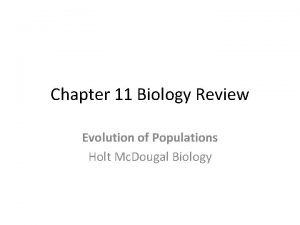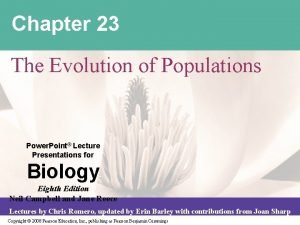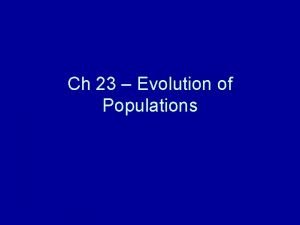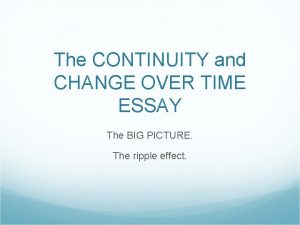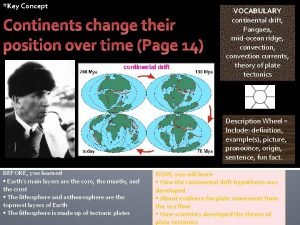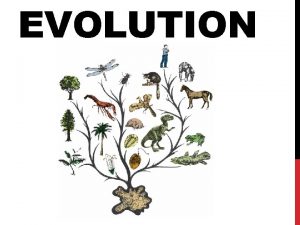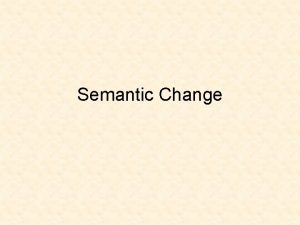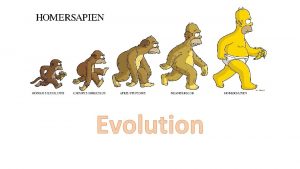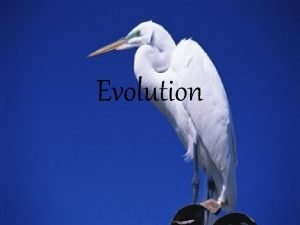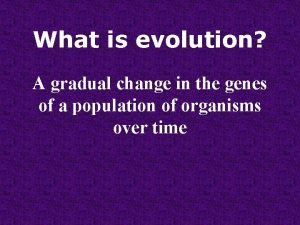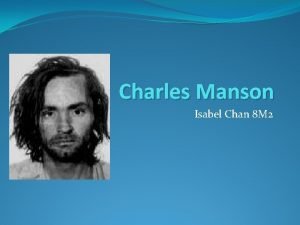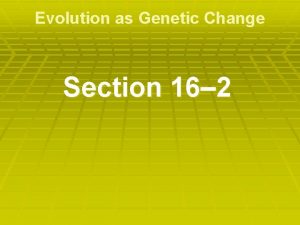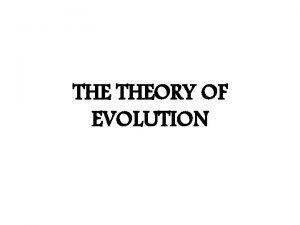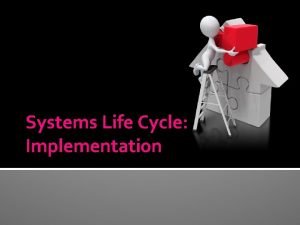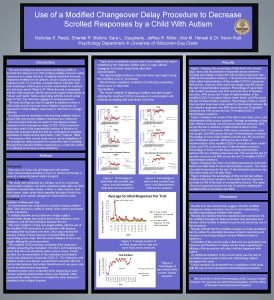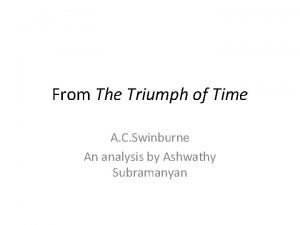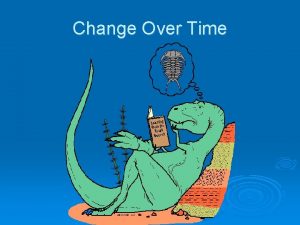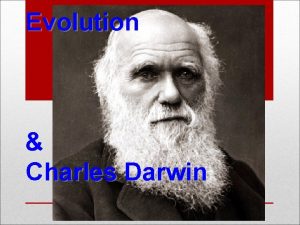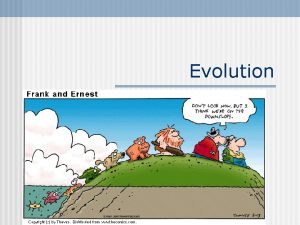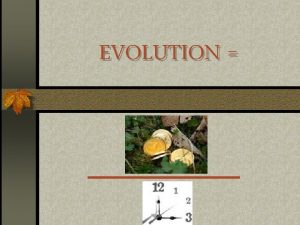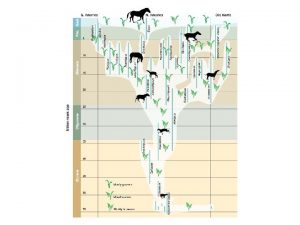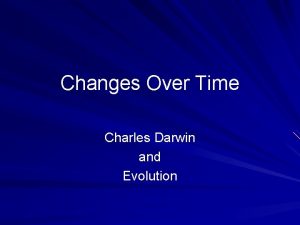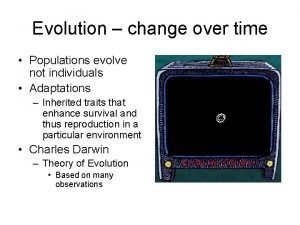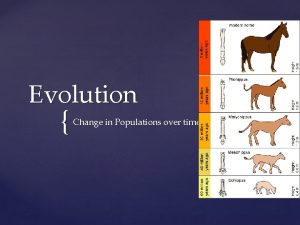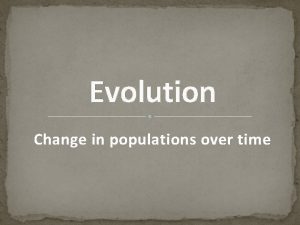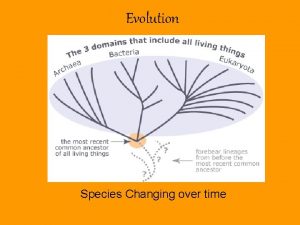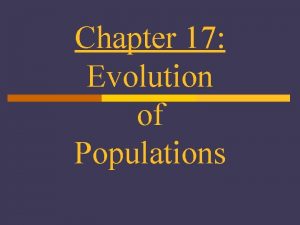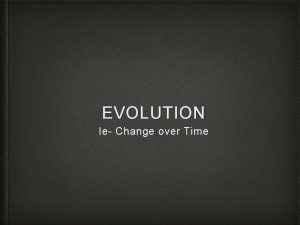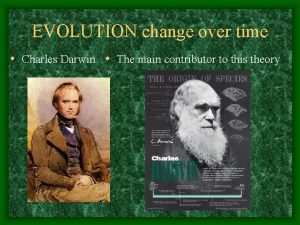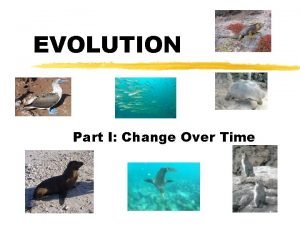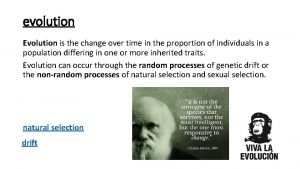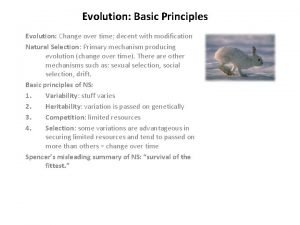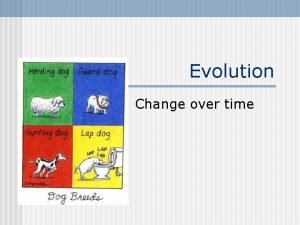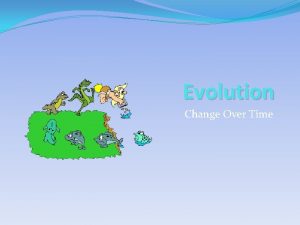EVOLUTION the CHANGE in populations over time CHARLES
































- Slides: 32

EVOLUTION the CHANGE in populations over time.

CHARLES DARWIN – English biologist who proposed theory of evolution – Wrote The Origin of Species in 1859 (20 years after voyage); very controversial

Darwin on HMS Beagle (a 5 year voyage)

Darwin explains natural selection:

1. VARIATION exists among members of a population Recall lab: the species of finch that varied in their beak shape! Fish, for example, may differ in color, size, and speed.

What causes variation? • Mutations (initially) • Sexual reproduction makes different combinations of traits possible

Adaptations: • A variation that helps an organism to survive

2. Those with adaptations survive and reproduce AND pass on the adaptation to the offspring • Ex. Speedy fish survive Recall lab: the spoon and fork varieties were more successful than the knife ones At getting pasta food. The survive and offspring inherit this successful variation.

3. Over time, successful variations make up most/all of the population • The population may look quite different from their ancestors Recall lab: After five generations, the knife variation was almost nonexistant, Whereas the fork and spoon numbers climbed.

Evidence For Evolution:

1. Direct Evidence for evolution: (we can see it happening in a short period of time). In bacteria, antibiotic resistance

How it happens: (p. 399) Non-resistant bacterium Antibiotic Resistant bacterium The bacteria in a population vary in their ability to resist antibiotics. When the population is exposed to an antibiotic, only the resistant bacteria survive. — natural selection! The resistant bacteria live and produce more resistant bacteria.

• Today, penicillin no longer kills as many species of bacteria because some species have “evolved” into penicillin-resistant populations.

2. Indirect Evidence for Evolution: (we can’t see it happening in a short period of time)

a. Fossils • they provide a record of early life and how it is different from species today • The fossil record is incomplete (most things decompose rapidly and do not fossilize)!)

Camel Evolution Age Organism Skull and teeth Limb bones Paleocene 65 million years ago Eocene 54 million years ago Oligocene 33 million years ago Miocene 23 million years ago Present

b. Anatomy • Structural features with a common evolutionary origin are called homologous structures. • Homologous structures can be similar in arrangement, in function, or in both. Crocodile forelimb Whale forelimb Bird wing

Anatomy (cont. ) • Analagous structures: no common ancestor, but have common function • For example, insect and bird wings probably evolved separately when their different ancestors adapted independently to similar ways of life.

Anatomy (cont. ) • Many organisms have vestigial structures that no longer have a function. • they show structural change over time. • Vestigial structures, such as pelvic bones in the baleen whale,

c. Embryology • the shared features in the young embryos that suggest evolution from a distant, common ancestor. Pharyngeal pouches Fish Pharyngeal pouches Reptile Bird Mammal • The embryos of a fish, a reptile, a bird, and a mammal have a tail and pharyngeal pouches.

d. Biochemistry If the makeup of certain molecules is more similar, that would suggest a closer evolutionary relationship. Percent Substitutions of Amino Acids in Cytochrome c Residues Comparison of Organisms Biochemical Similarities of Organisms Two orders of mammals 5 and 10 Birds vs. mammals 8 -12 Amphibians vs. birds Fish vs. land vertebrates Insects vs. vertebrates Algae vs. animals 14 -18 18 -22 27 -34 57

Convergent Evolution = different species evolve in similar ways

Divergent Evolution: same ancestral species evolve different adaptations over time due to different environments

Some Structural Adaptations:

Mimicry: One species resembles another species The viceroy (Limenitis sp. ; right) and monarch (Danaus sp. ) butterflies look very similar but may differ in their taste to avian predators.

Camouflage= kind of mimicry in which a species blends in with its surroundings



• NPR Too Big to Publish http: //www. npr. org/templates/story. php? story. Id=100542500&ps=rs

NPR interview

• http: //www. youtube. com/watch? v=XV 8 h 6 J H 8 z. Vw&safety_mode=true&persist_safety _mode=1&safe=active • http: //www. youtube. com/watch? v=Pv. Ai 8 m 7 EUgc&safety_mode=true&persist_safety _mode=1&safe=active

Darwin’s finches • http: //www. youtube. com/watch? v=l 25 MBq 8 T 77 w&safety_mode=true&persist_safety _mode=1&safe=active
 Stabilizing selection human birth weight
Stabilizing selection human birth weight Chapter 16 evolution of populations vocabulary review
Chapter 16 evolution of populations vocabulary review Chapter 17 evolution of populations answer key
Chapter 17 evolution of populations answer key Chapter 23: the evolution of populations
Chapter 23: the evolution of populations Evolution of populations section 16-1 genes and variation
Evolution of populations section 16-1 genes and variation Chapter 16 evolution of populations
Chapter 16 evolution of populations Evolution of populations section 11 review
Evolution of populations section 11 review Chapter 23 the evolution of populations
Chapter 23 the evolution of populations Why are populations the smallest unit of evolution
Why are populations the smallest unit of evolution Continuity and change essay
Continuity and change essay Why do communities change over time
Why do communities change over time Continents change position over time
Continents change position over time The gradual change in a species over time
The gradual change in a species over time Semantic shift meaning
Semantic shift meaning The change in the hereditary features over time
The change in the hereditary features over time The gradual change in living communities
The gradual change in living communities Mutation
Mutation Change in hereditary features over time
Change in hereditary features over time The gradual change in a species over time is
The gradual change in a species over time is Why do classification systems change over time?
Why do classification systems change over time? Charles darwin theory of evolution
Charles darwin theory of evolution Charles luther manson
Charles luther manson Example of elapsed time
Example of elapsed time Over the mountains over the plains
Over the mountains over the plains Siach reciting the word over and over
Siach reciting the word over and over Taking over navigational watch
Taking over navigational watch 16-2 evolution as genetic change
16-2 evolution as genetic change Industry evolution and strategic change
Industry evolution and strategic change Model of evolution showing slow change
Model of evolution showing slow change Direct changeover method
Direct changeover method Change over delay
Change over delay Swinburne
Swinburne Charles dickens time period
Charles dickens time period






